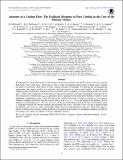Anatomy of a Cooling Flow: The Feedback Response to Pure Cooling in the Core of the Phoenix Cluster
Author(s)
McDonald, M.; McNamara, B. R.; Voit, G. M.; Bayliss, Matthew B; Benson, B. A.; Brodwin, M.; Canning, R. E. A.; Florian, M. K.; Garmire, G. P.; Gaspari, M.; Gladders, M. D.; Hlavacek-Larrondo, J.; Kara, Erin A; Reichardt, C. L.; Russell, H. R.; Saro, A.; Sharon, K.; Somboonpanyakul, T.; Tremblay, G. R.; Weeren, R. J. van; ... Show more Show less
DownloadPublished version (2.533Mb)
Publisher Policy
Publisher Policy
Article is made available in accordance with the publisher's policy and may be subject to US copyright law. Please refer to the publisher's site for terms of use.
Terms of use
Metadata
Show full item recordAbstract
We present new, deep observations of the Phoenix cluster from Chandra, the Hubble Space Telescope, and the Karl Jansky Very Large Array. These data provide an order-of-magnitude improvement in depth and/or angular resolution over previous observations at X-ray, optical, and radio wavelengths. We find that the one-dimensional temperature and entropy profiles are consistent with expectations for pure-cooling models. In particular, the entropy profile is well fit by a single power law at all radii, with no evidence for excess entropy in the core. In the inner ∼10 kpc, the cooling time is shorter than any other known cluster by an order of magnitude, while the ratio of the cooling time to freefall time (t cool/t ff) approaches unity, signaling that the intracluster medium is unable to resist multiphase condensation on kpc scales. The bulk of the cooling in the inner ∼20 kpc is confined to a low-entropy filament extending northward from the central galaxy, with t cool/t ff ∼ 1 over the length of the filament. In this filament, we find evidence for ∼1010 M o in cool (∼104 K) gas (as traced by the [O ii]λλ3726,3729 doublet), which is coincident with the low-entropy filament and absorbing soft X-rays. The bulk of this cool gas is draped around and behind a pair of X-ray cavities, presumably bubbles that have been inflated by radio jets. These data support a picture in which active galactic nucleus feedback is promoting the formation of a multiphase medium via uplift of low-entropy gas, either via ordered or chaotic (turbulent) motions.
Date issued
2019-10Department
Massachusetts Institute of Technology. Department of Physics; MIT Kavli Institute for Astrophysics and Space ResearchJournal
Astrophysical Journal
Publisher
American Astronomical Society
Citation
McDonald, M. et al. "Anatomy of a Cooling Flow: The Feedback Response to Pure Cooling in the Core of the Phoenix Cluster." Astrophysical Journal 885, 1 (October 2019): 63 © 2019 American Astronomical Society
Version: Final published version
ISSN
1538-4357